
Suzuki Let's vs Honda Activa i vs Yamaha Ray: Spec Comparison
- May 22, 2014
- Views : 118390

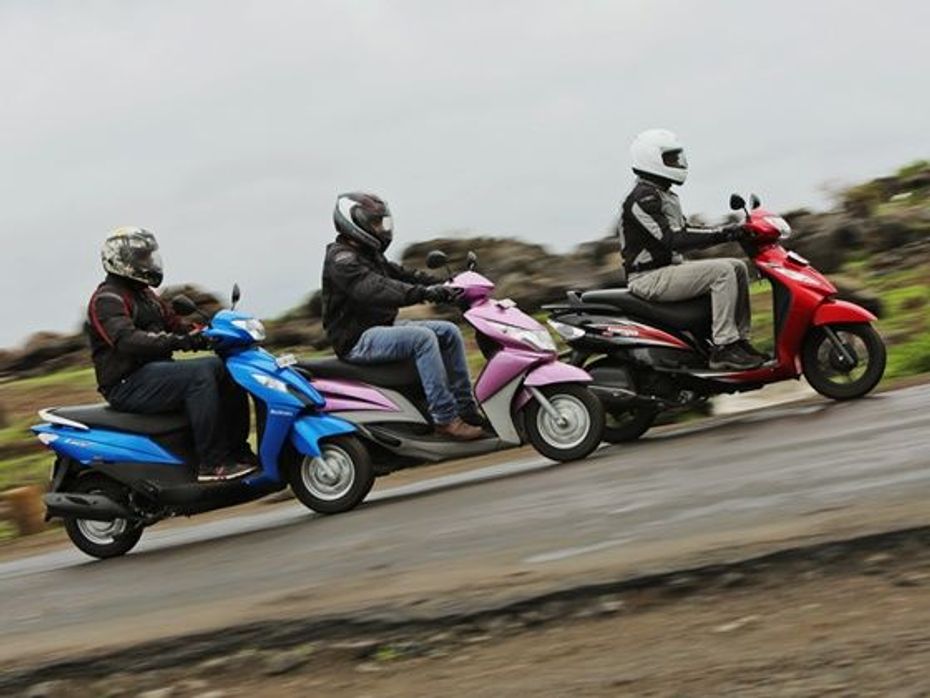
It is no revelation that scooter sales have been rising with every passing month; one can see their ever increasing numbers while commuting or at parking lots. If we talk about numbers, scooters registered a growth of close to 18 per cent while motorcycles managed a measly 3 to 5 per cent last year. One of the major reasons for the popularity of gearless scooters is their versatility, as unlike motorcycles these aren’t just restricted or targeted at male users.
Naturally, every two wheeler maker in India wants to cash in on scooters. And the more recent entrants (with a slight bent of mind to please the fairer sex) have been the Yamaha Ray and the Suzuki Let’s. Now, TVS has updated its Wego to give it more than a fighting chance in this class. Here’s how the three fare…
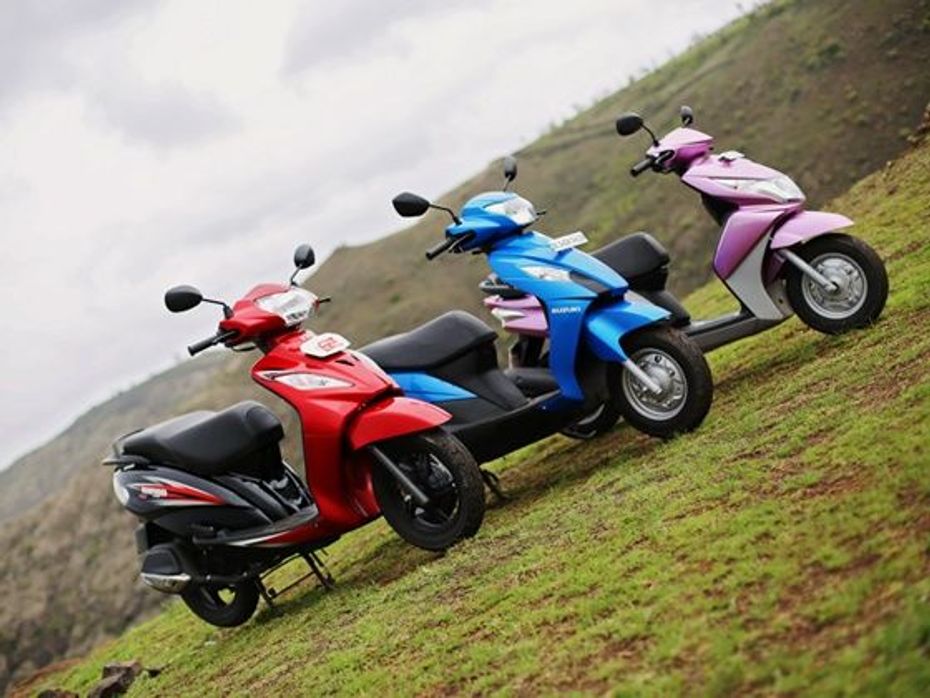
Design & Features
The first thing that one notices about the Suzuki Let’s is its compact dimensions. Despite the fact that it follows the path of traditional scooter styling with handlebar mounted headlamp and other similar traits, the edgy lines endows the scooter a hint of sportiness. Other details that add to its visual appeal include the neatly integrated turn indicators on the front fairing, the eye-catchy tail section and the dual-tone finish in bright and attractive colour options.
The instrument cluster is basic with an analogue speedometer, fuel gauge and odometer. I personally didn’t like the faux carbon fibre finish around the console whereas the switch gear quality is decent. Despite its compact dimension, the Suzuki Let’s has an under seat storage of 18-litres, which is the highest among the trio and it gets a mobile charger point as well, though as an optional extra.
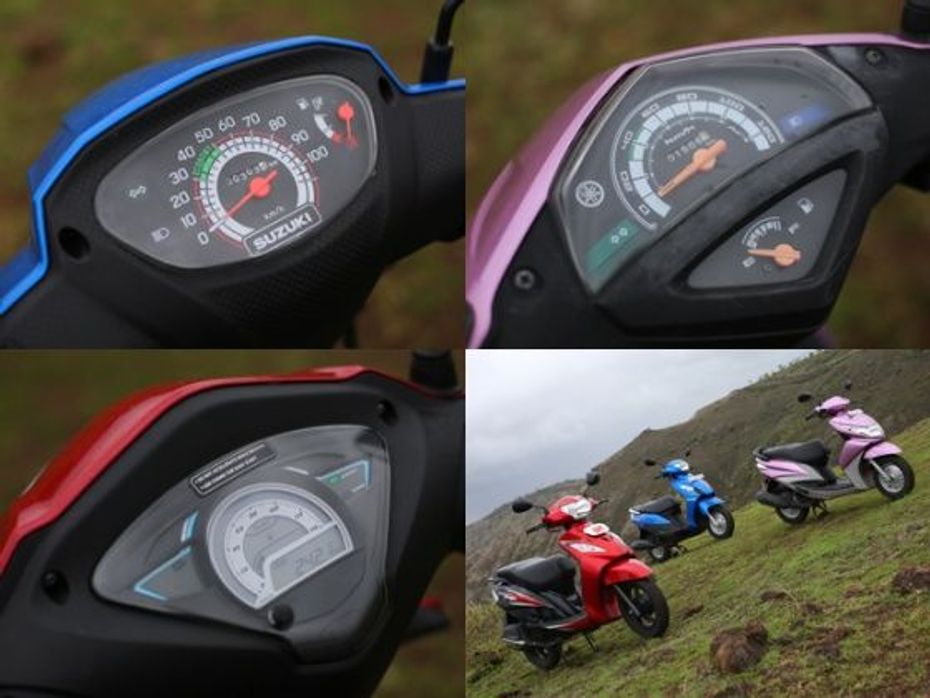
The TVS Wego was always a nice looking scooter and the new updates like the black alloy wheels and telescopic forks, dual-tone body colour and the Jupiter sourced exhaust muffler have added an extra oomph to the Wego in terms of visual appeal. Another major addition on the new TVS Wego is the fully digital instrument console, which sets it apart from the Let’s and the Ray. The digital console houses plethora of information like speedometer, odometer, fuel gauge, service reminder, battery indicator and the TVS characteristic power and economy mode indicator. Switch gear quality is good too. The TVS Wego has an under seat storage capacity of 16-litres and the mobile charger is standard. It sports a convenient external fuel lid as well.
The sharp and well sculpted lines of the Yamaha Ray make it the most handsome looking scooter of the trio even in a shade of dull pink we have here. Despite the fact that it is large in terms of proportions, the body mounted V-shaped headlamp, leg shields and a sharp tail section aid the Ray in masking its size well. The triangle shaped analogue instrument cluster is easy to read and the switch gear quality is also up to the mark. But it has the least under seat storage capacity of just 15.5-litres. However, it falls short in a few areas; lack of tubeless tyres being one crucial one.

Design & Features:
TVS Wego: 4.5
Suzuki Let’s: 4
Yamaha Ray: 4
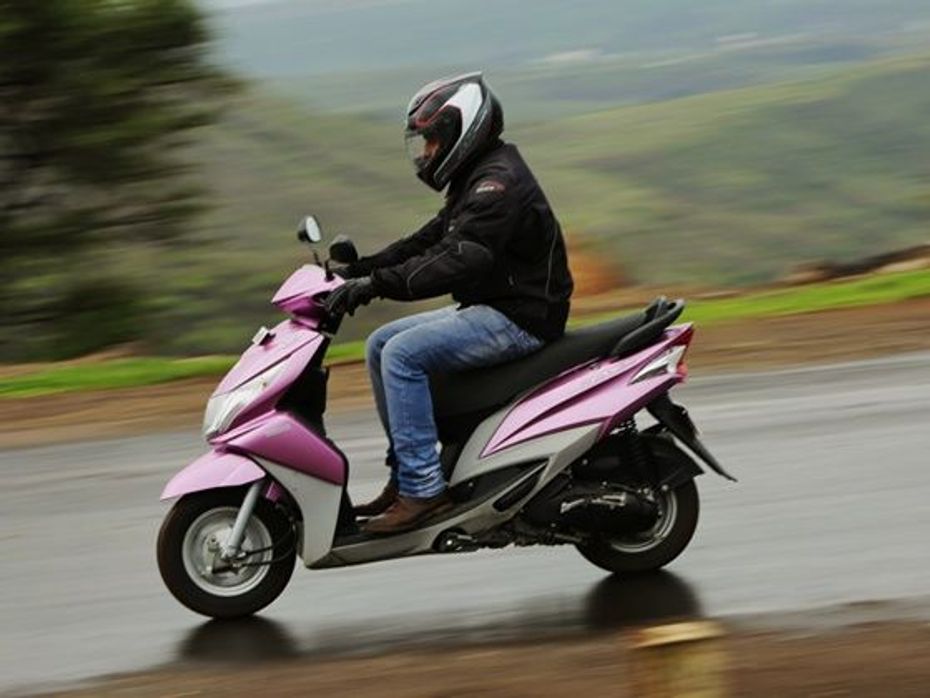
Engine & Performance
The basic powerplant recipe for all three scooters is the same - a near 110cc motor mated to a CVT transmission. On paper the Suzuki Let’s’ 113cc, air-cooled motor is the most potent with a power output of 8.7PS at 7,500rpm and a peak torque rating of 9Nm at 6,500rpm. It’s also the lightest of the lot at just 98kg. And these figures prove their point in real world riding conditions as it feels the peppiest of the lot. It could nonetheless do with a better mid-range. The Suzuki motor is also refined.
The TVS Wego’s 110cc, air-cooled heart churns out 8.1PS at 7,500rpm and 8Nm at 5500rpm. TVS has worked on improving the refinement of the powerplant and the new Wego’s motor feels a bit more polished. Power delivery is linear but lazier in order to improve fuel efficiency making the Wego the least fun to ride.

The Yamaha Ray’s 113cc is the least powerful here making 7.1PS at 7,500rpm and 8.1Nm of torque at 5,500rpm. On the road, though, it feels more eager and lively than the TVS but less sprightly than the Suzuki. What also works in the Ray’s favour is its smooth engine and the well calibrated CVT. It hardly has any vibration seeping through the body or handlebar, no matter how high the revs making this the most refined powerplant of the three.
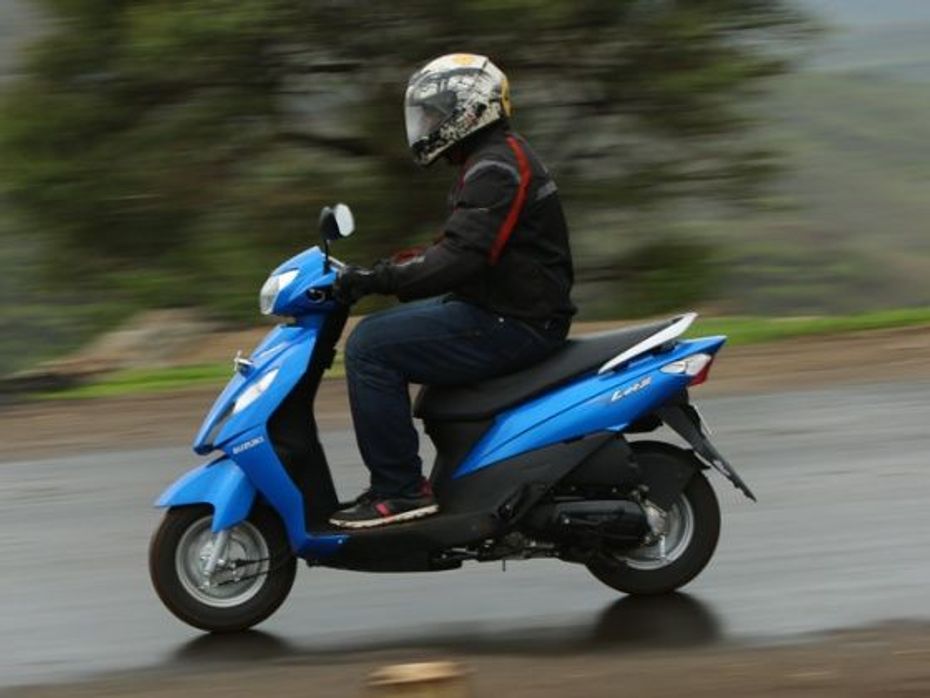
Engine & Performance
Yamaha Ray: 4.5
Suzuki Let’s: 4
TVS Wego: 3.5
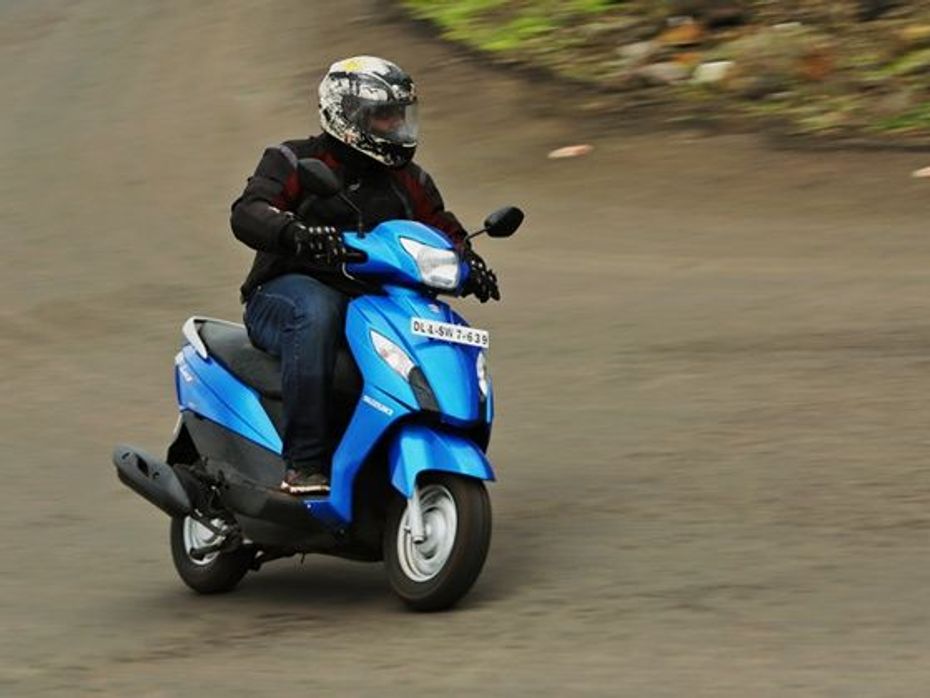
Ride & Handling:
The Let’s has surprisingly good room for a scooter that’s not exactly ‘full-size’. The latter has its pluses: it makes the Suzuki easy to dart around with in traffic; and its downsides: the handlebar fouls with the rider’s thighs at full lock. The seat though is well cushioned and the rider’s seating posture isn’t uncomfortable either. However, despite the Suzuki Let’s running telescopic forks at the front, the ride quality isn’t city-friendly. We do like the bite offered by its drum brakes though.
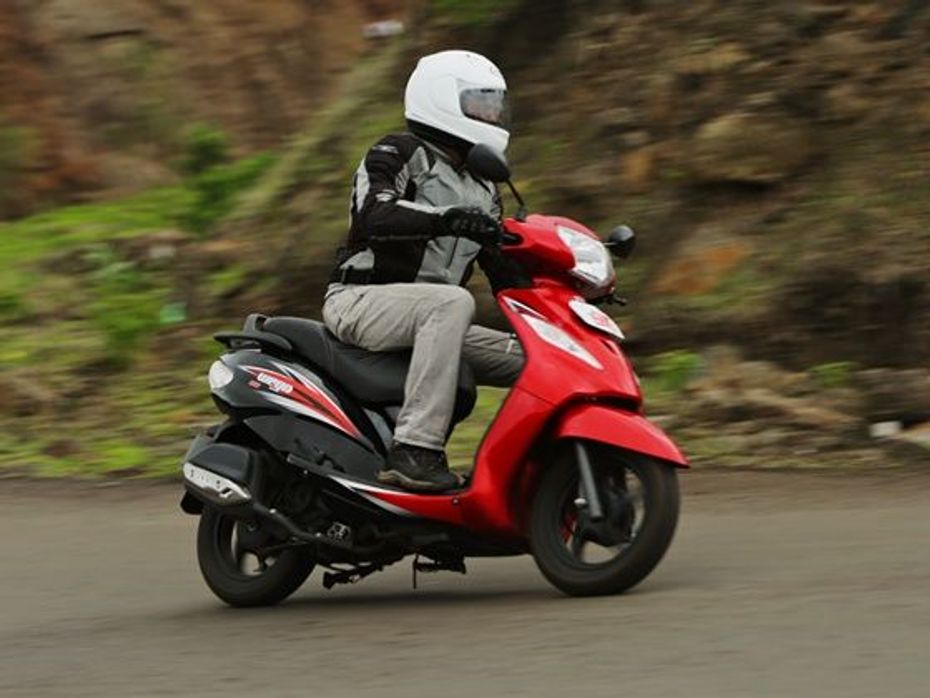
The drum brakes on the TVS Wego aren’t as impressive. This drawback can be easily countered by selecting the optional front disc brake, which it costs money. The large foot board and the ergonomically sound seating posture though, come as standard on the Wego. We do wish it had a more supportive seat. Handling wise the Wego is neutral but nowhere as sharp as the Suzuki. It does ride better which should endear it to the city commuting crowd.
The Yamaha Ray has the widest and the best damped seats and a comfortable and upright riding posture. The Ray is also nimble on its feet at slow speeds in traffic and lively at speed around a corner. It rides well too. The Yamaha Ray handled the broken roads and potholes with aplomb while the brakes provide great feedback and bite.

Ride & Handling:
Yamaha Ray: 4
Suzuki Let’s: 3.5
TVS Wego: 3
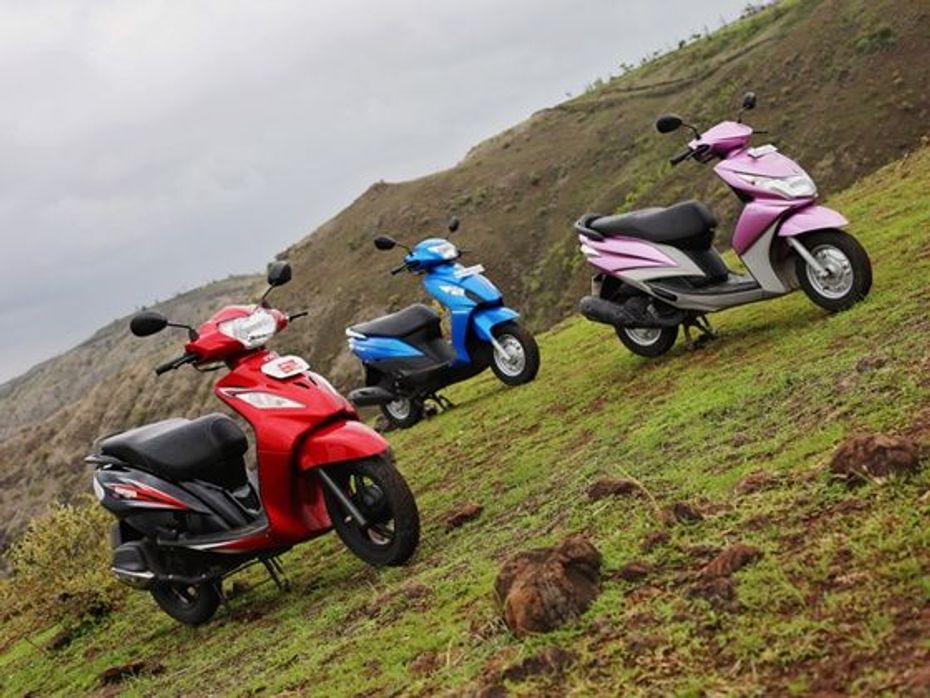
Price & Fuel Efficiency:
Despite being the most powerful scooter in the comparison, the Suzuki leads the charge come fuel efficiency. Owing to its light 98kg kerb weight and engine efficiency based tech Suzuki claims an overall fuel efficiency figure of 63kmpl for the Let’s. This figure can be credited to Suzuki’s Eco Performance technology (SEP) that reduces friction among the mating parts and improves combustion.
The new Wego’s powerplant has been tuned for better efficiency as well and TVS claims that the scooter can go on for 62km in a litre of fuel. The Yamaha Ray meanwhile comes with a claimed fuel efficiency of 53kmpl making it the least fuel efficient of the lot. As far as pricing goes, the Suzuki Let’s at Rs 43,430 (ex-showroom Delhi) is the most affordable scooter here, followed by the Yamaha Ray that costs Rs 2,000 more and then the TVS which is dearer by another Rs 1000.
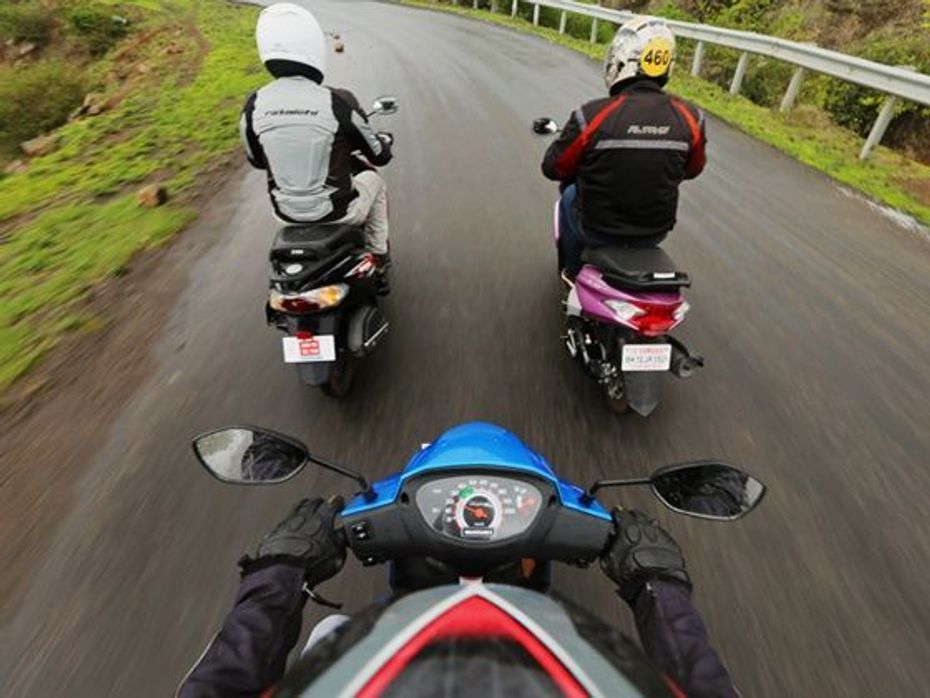
Price & Fuel Efficiency:
Suzuki Let’s: 4.5
TVS Wego: 4
Yamaha Ray: 3

Verdict:
The Yamaha Ray is a striking scooter with an eager powerplant, comfortable ride quality and lively handling dynamics. But, it doesn’t win this test mainly thanks to its relatively poor fuel economy coupled with a higher price tag compared to the Suzuki. It costs Rs 2,000 more and delivers nearly 10kmpl less than the Let’s.
The Ray finishes a joint second with the TVS Wego. The Wego too has its high points like class leading features and a modern aura. It’s also economical even though not as much as the Let’s. The Wego, however, is let down by its lacklustre engine performance and handling that’s not as well attuned to city as the other scooters here. It’s also the most expensive scooter in this test.
The Suzuki Let’s then is our winner. It doesn’t score as well as the other two when it comes to comfortable ride quality or usable space, but in every other regard, it’s right up there with the competition, if not ahead. It is styled right and it has the liveliest of engines - which commendably is also the most fuel efficient. It’s easy to ride in the city, more than manageable at higher speeds and also the lightest. But most of all, Suzuki is the most affordable scooter here making it, undoubtedly, the best value purchase.
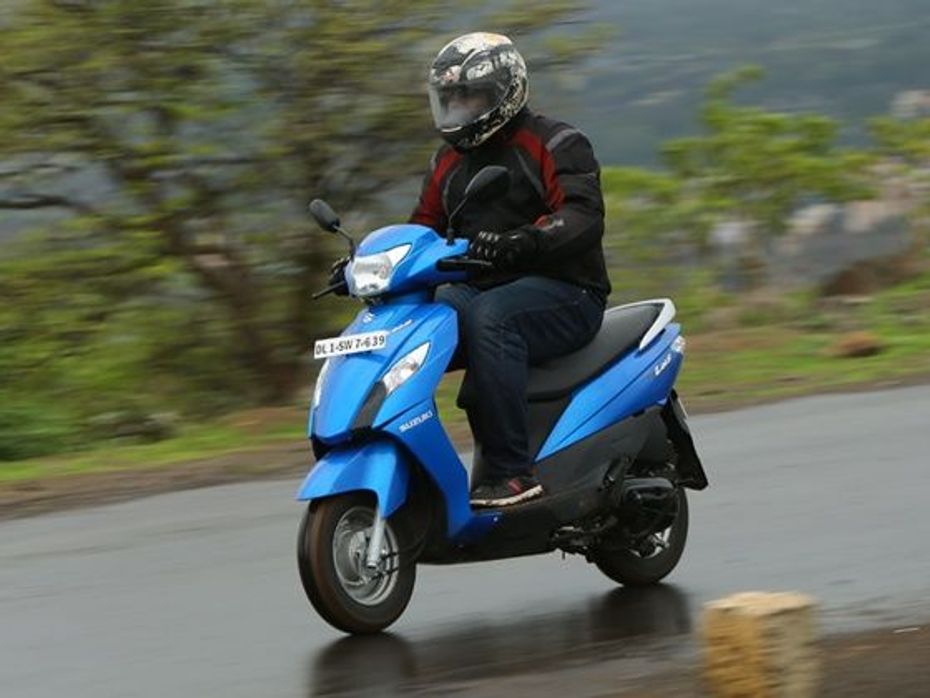
Verdict:
Suzuki Let’s: 4
TVS Wego: 3.5
Yamaha Ray: 3.5

Suzuki Let's vs Honda Activa i vs Yamaha Ray: Spec Comparison

Incoming: An Electric Two-wheeler From Suzuki By 2020

Suzuki Lets Now Available In Dual-Tone Colours

Suzuki unveils BS-IV Let’s and Hayate EP

Suzuki Lets scooter gets new colour

Suzuki launches Let's, a new 110cc scooter

Suzuki Let's to cost Rs 47,000

2014 new Suzuki Let's preview

Suzuki Let's scooter unvieled
 Mahindra Scorpio N
Mahindra Scorpio N
 Royal Enfield Hunter 350
Royal Enfield Hunter 350
 Toyota Fortuner
Toyota Fortuner
 Royal Enfield Classic 350
Royal Enfield Classic 350
 Hyundai Creta
Hyundai Creta
India's largest automotive community
 Maruti Brezza
Rs. 8.34 Lakh
Maruti Brezza
Rs. 8.34 Lakh
 Maruti FRONX
Rs. 7.51 Lakh
Maruti FRONX
Rs. 7.51 Lakh
 Maruti Grand Vitara
Rs. 10.99 Lakh
Maruti Grand Vitara
Rs. 10.99 Lakh
 Mahindra Scorpio
Rs. 13.61 Lakh
Mahindra Scorpio
Rs. 13.61 Lakh
 Toyota Innova Crysta
Rs. 19.99 Lakh
Toyota Innova Crysta
Rs. 19.99 Lakh